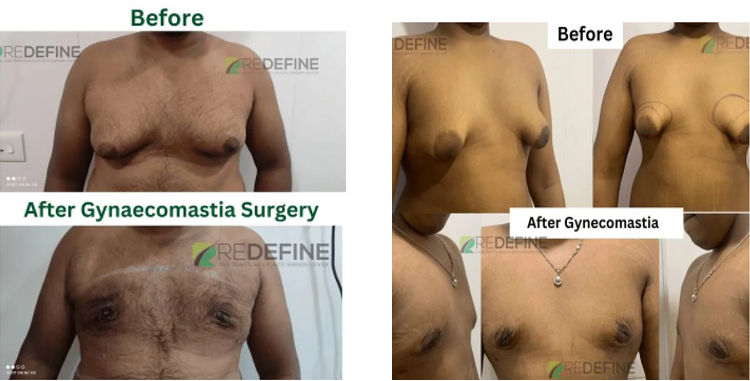Are you planning to undergo gynecomastia surgery or recovering from it? Do you feel anxious about what to expect 1 week after gynecomastia surgery? It’s natural to have questions and concerns about this crucial period.
“At the one-week mark post-surgery, you’ll likely experience some swelling, bruising, and discomfort around the treatment area,” explains Dr. Harikiran Chekuri, a prominent plastic surgeon in Hyderabad. “Following the post-operative care instructions is essential to ensure a smooth recovery. With proper care and patience, you can expect positive results.”
At the Redefine Gynecomastia Clinic, Dr. Harikiran Chekuri offers top-notch, cost-effective gynecomastia treatment in Hyderabad. From managing post-operative discomfort to tracking progress, he ensures the recovery process is as smooth and comfortable as possible.
In this blog, we’ll explore what to expect during the crucial phase of gynecomastia 1 week post op, address common concerns, and offer tips to optimize recovery.
What to Expect 1 Week After Gynecomastia Surgery?
Here’s the lowdown on what you can expect during gynecomastia surgery 1 week post op:
- Swelling and Bruising:
You’ll likely still have some swelling and bruising around the chest area. Don’t worry; this is normal and should diminish gradually.
- Discomfort:
You might still experience some discomfort. But it should be much less intense than right after the surgery. OTC pain relievers can help manage any lingering pain.
- Activity Level:
While gently moving around is essential, avoiding strenuous activities or heavy lifting during this time is crucial. Your body needs time to heal properly.
- Support Garments:
You should continue to wear compression garments as instructed by your surgeon. It will help reduce swelling and support your chest area.
- Follow-up Appointment:
You will likely have follow-up appointments with your surgeon. It will help monitor your progress and ensure proper healing.
Understanding the recovery process is critical to a smooth healing journey.
Recovery After Gynecomastia Surgery
- Healing Progress:
- Managing Discomfort:
It’s normal to feel pain during the initial recovery period. However, this discomfort should gradually decrease over time. Follow your surgeon’s instructions regarding pain management medication and activity restrictions.
- Staying Active:
After a few weeks of recovery, light walking and gentle movements can help with circulation. Listen to your body and avoid anything that causes discomfort.
- Follow-up Appointment:
Typically, you’ll have a follow-up appointment with your surgeon around this time. This is an excellent opportunity to address any concerns and ensure your recovery progresses as expected.
“Remember, everyone’s recovery timeline is different,” mentions Dr. Harikiran Chekuri. “Be patient with yourself and trust the process. Your body is working hard to heal. With time, you’ll start seeing the results of your surgery.”
Elevate your recovery experience with expert advice. Reach out today.
Let’s explore the signs of progress and improvements you might notice.
Results & Improvements Seen

- Swelling reduction:
Noticeable decrease in swelling around the chest area.
- Bruising fades:
Bruising begins to fade, revealing a smoother skin tone.
- Decreased discomfort:
Reduction in post-operative discomfort and tenderness.
- Increased mobility:
Greater ease in movement and daily activities due to reduced swelling and discomfort.
Worried about potential complications? Let’s address your concerns head-on. Stay informed to navigate any bumps in the road.
Side Effects & Complications

- Numbness or Tingling:
It’s normal to feel numb or tingling sensations around the chest area due to nerve irritation during surgery. This typically resolves as healing progresses.
- Scarring:
Scarring is unavoidable after surgery. However, your surgeon will make incisions in unnoticeable areas to minimize visibility. To promote optimal healing, you should follow proper wound care instructions.
- Infection:
Though rare, there is a risk of infection after gynecomastia surgery. Keep the surgical site clean and dry. Report any signs of infection, such as increased redness, swelling, or pus, to your surgeon immediately.
- Asymmetry:
Initially, there may be some asymmetry in the chest contour. However, it usually resolves as the swelling goes down and tissues settle. Be patient, as the final results may take several weeks to months to appear completely.
- Seroma or Hematoma:
After surgery, fluid accumulation (seroma) or blood collection (hematoma) may occur under the skin. Your surgeon may need to drain these fluid collections to prevent complications.
- Changes in Sensation:
You may notice temporary changes in sensation around the chest area, such as increased or decreased sensitivity. This is usually temporary and resolves over time as nerves regenerate.
Remember, these side effects and complications are possible. Most patients experience a smooth recovery with excellent outcomes.
Looking for support from experienced professionals? Contact us today.
Discover essential guidelines to ensure a smooth recovery journey.
Post Op Guidelines
- Stay Hydrated:

Drink plenty of fluids to aid in the healing process and prevent dehydration.
- Follow Medication Instructions:

Take prescribed medications as directed to manage pain and reduce the risk of infection.
- Wound Care:
Keep the surgical site clean and dry. Follow your surgeon’s instructions for dressing changes and showering.
- Avoid Strenuous Activities:
Refrain from heavy lifting, vigorous exercise, or activities that strain the chest muscles. It will help prevent complications and promote proper healing.
- Attend Follow-Up Appointments:

Attend follow-ups with your surgeon for post-operative assessments and any necessary adjustments to your treatment plan.
- Wear Compression Garments:
Wear compression garments as your surgeon recommends. It will help minimize swelling and support the chest area during healing.
- Maintain a Healthy Diet:

Eat nutritious foods to support your body’s healing process and promote optimal recovery.
- Rest & Relaxation:

Allow yourself ample time to rest and recuperate following surgery. Avoid excessive physical exertion and prioritize adequate sleep for optimal healing.
- Follow Dietary Restrictions:
Adhere to any dietary restrictions provided by your surgeon. These include avoiding certain foods or beverages that may interfere with healing or increase the risk of complications.
Adhering to these guidelines will help you recover smoothly after gynecomastia surgery. Contact your surgeon if you have any questions.
Conclusion
As you approach the critical phase of 1 week after gynecomastia surgery, it is crucial to acknowledge the progress you have made and the milestones you have achieved. Although the journey may have presented challenges, you have demonstrated resilience and determination in embracing your transformation. Remember to follow your surgeon’s instructions, maintain a healthy lifestyle, and prioritize self-care as you progress through recovery. With perseverance and the right support system, you’re well on your way to experiencing the positive transformation you deserve. Dr. Harikiran Chekuri and his team at Redefine Gynecomastia Clinic are here to support you throughout your recovery journey.
Don’t hesitate to reach out—we’re here to provide the support and guidance you need.
Find answers to common queries about gynecomastia surgery in our FAQs section.
Frequently Asked Questions:
1. How long does it take to recover from gynecomastia surgery?
Recovery times vary, but typically, it takes around 1-2 weeks for initial healing and several weeks to months for complete recovery.
2. When can I return to work after gynecomastia surgery?
Depending on your work type, you can resume within 1-2 weeks if it’s not physically demanding.
3. Will I have scars after gynecomastia surgery?
Scarring is inevitable, but it is typically minimal and improves over time.
4. Can gynecomastia come back after surgery?
It’s possible, but recurrence rates are low, especially with proper lifestyle changes.
5. When can I resume exercise after gynecomastia surgery?
You can resume light activities after a few weeks. But you should avoid strenuous exercise for about 4-6 weeks.
6. Will insurance cover gynecomastia surgery?
It depends on your insurance policy and the medical necessity of the procedure.
7. How soon can I see the results of gynecomastia surgery?
Initial results are visible shortly after surgery. But final results may take several months as swelling subsides.
Reference links:
https://www.healthline.com/health/what-is-gynecomastia-surgery


Recent Comments